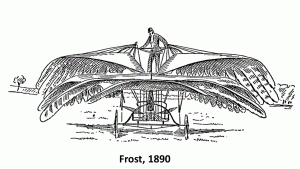Inspired by the anatomy of a crow, in 1890 Mr. E.P. Frost built a “steam-bird” whose feathered wings were 30-feet long, from tip to tip. The apparatus weighed in at 650 pounds, not counting the pilot, and the illustration shows various positions which the wings would assume in flight.
In Progress in Flying Machines, Octave Chanute explains this design was unable to take off because “the maker of the engine failed in his contract to secure the necessary power.”
Frost’s machine had an inadequate lift-to-weight ratio, which as every Monty Python fan knows is what prevents European swallows from carrying coconuts to England. Just as a five-ounce bird cannot carry a one-pound coconut, a flying machine must produce sufficient lift to overcome gravity’s pull on its mass. Frost’s device didn’t do that, so there it sat, safely on the ground.
This was a common limitation of flying machines, and many inventors tried (unsuccessfully) to build or purchase a lightweight engine that also provided sufficient power to get off the ground. But the real reason Frost’s machine did not fly probably had something to do with the fact that feathers are less important and helpful than he thought they would be.
LESSON: If your engine can only lift 300 lbs, don’t build a 650 lb machine. Also, skip the feathers next time.
